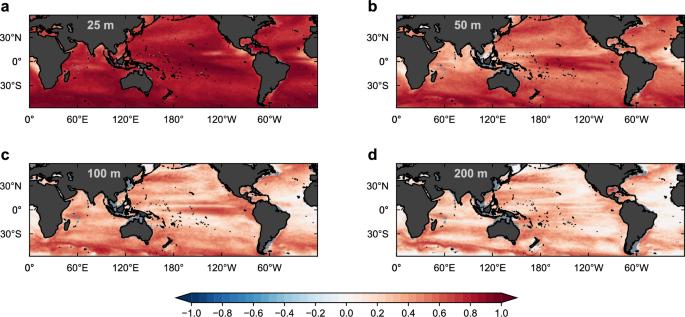Detecting marine heatwaves below the sea surface globally using dynamics-guided statistical learning
IF 8.1
1区 地球科学
Q1 ENVIRONMENTAL SCIENCES
引用次数: 0
Abstract
Extreme warm water events, known as marine heatwaves, cause a variety of adverse impacts on the marine ecosystem. They are occurring more and more frequently across the global ocean. Yet monitoring marine heatwaves below the sea surface is still challenging due to the sparsity of in situ temperature observations. Here, we propose a statistical learning method guided by ocean dynamics and optimal prediction theory, to detect subsurface marine heatwaves based on the observable sea surface temperature and sea surface height. This dynamics-guided statistical learning method shows good skills in detecting subsurface marine heatwaves in the oceanic epipelagic zone over many parts of the global ocean. It outperforms both the classical ordinary least square regression and popular deep learning methods that do not effectively exploit ocean dynamics, with clear dynamical interpretation for its outperformance. Our study provides a useful statistical learning method for near real-time monitoring of subsurface marine heatwaves at a global scale and highlights the importance of exploiting ocean dynamics for enhancing the efficiency and interpretability of statistical learning. Subsurface marine heatwaves in the oceanic epipelagic zone can be detected based on satellite-measured sea surface temperature and height anomalies, by using a statistical learning method guided by ocean dynamics.

利用动态指导的统计学习在全球范围内探测海面以下的海洋热浪
被称为海洋热浪的极端暖水事件会对海洋生态系统造成各种不利影响。它们在全球海洋中发生的频率越来越高。然而,由于原位温度观测数据稀少,监测海面以下的海洋热浪仍然具有挑战性。在此,我们提出了一种以海洋动力学和最优预测理论为指导的统计学习方法,根据可观测到的海面温度和海面高度来探测海面下的海洋热浪。这种以动力学为指导的统计学习方法在探测全球海洋多处大洋上深海区的次表层海洋热浪方面显示出良好的技能。它的表现优于经典的普通最小二乘法回归法和不能有效利用海洋动力学的流行深度学习方法,其优越性有明确的动力学解释。我们的研究为近实时监测全球范围的次表层海洋热浪提供了一种有用的统计学习方法,并强调了利用海洋动力学提高统计学习效率和可解释性的重要性。利用海洋动力学指导下的统计学习方法,可以根据卫星测量到的海面温度和高度异常,探测到大洋表层下海洋热浪。
本文章由计算机程序翻译,如有差异,请以英文原文为准。
求助全文
约1分钟内获得全文
求助全文
来源期刊

Communications Earth & Environment
Earth and Planetary Sciences-General Earth and Planetary Sciences
CiteScore
8.60
自引率
2.50%
发文量
269
审稿时长
26 weeks
期刊介绍:
Communications Earth & Environment is an open access journal from Nature Portfolio publishing high-quality research, reviews and commentary in all areas of the Earth, environmental and planetary sciences. Research papers published by the journal represent significant advances that bring new insight to a specialized area in Earth science, planetary science or environmental science.
Communications Earth & Environment has a 2-year impact factor of 7.9 (2022 Journal Citation Reports®). Articles published in the journal in 2022 were downloaded 1,412,858 times. Median time from submission to the first editorial decision is 8 days.
 求助内容:
求助内容: 应助结果提醒方式:
应助结果提醒方式:


